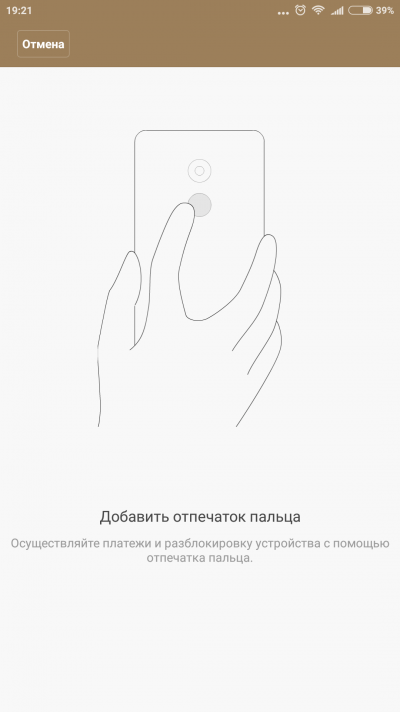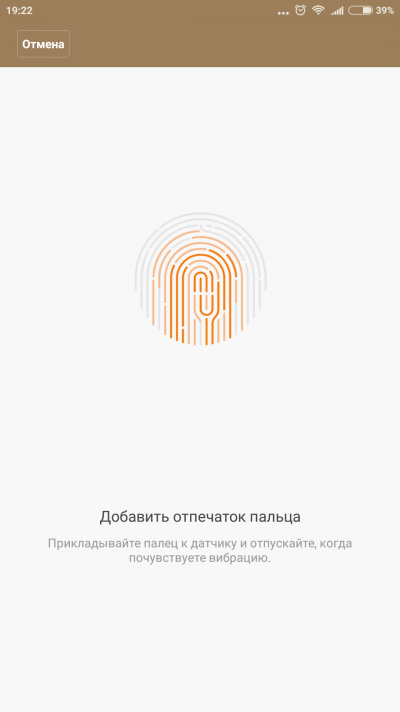Xiaomi Mi MIX - Specifications. The screen of a mobile device is characterized by its technology, resolution, pixel density, diagonal length, color depth, etc. Mobile communication technologies and data transfer rate
Today, our focus is Xiaomi Mi Mix – perhaps the most unusual smartphone of this year, worthy of a separate review, a kind of “serial concept”.
UPD. dated 1 November. Already now you can order the exclusive Xiaomi Mi Mix with delivery anywhere in the world. Keep in mind - this smartphone will not be officially shipped to Russia, Europe, or the USA.
Best prices for new Xiaomi smartphones
| Xiaomi Mi6 | Snapdragon 835, 6 Gb RAM, 64 Gb Flash, 2 x 12 Mp camera | $789.99 $586.92 | Buy |
|---|---|---|---|
| Xiaomi Mi5s | Snapdragon 821, 3 Gb RAM, 64 Gb Flash, 12 Mp camera | $499.99 $355.64 | Buy |
| Xiaomi Mi5 | Snapdragon 820, 3 Gb RAM, 64 Gb Flash, 12 Mp camera | $379.99 $228.99 | Buy |
| Xiaomi Redmi 4 | Snapdragon 430, 2 Gb RAM, 16 Gb Flash, 12 Mp camera | $129.99 $115.99 | Buy |
| Xiaomi Redmi Note 3 Pro | Snapdragon 650, 3 Gb RAM, 32 Gb Flash, 16 Mp camera | $229.99 $197.89 | Buy |
The fact is that this innovative gadget was originally planned, apparently, exclusively as a prototype “for the future”, but in the end, the manufacturer decided to release it as an exclusive model.
In principle, this approach to creating Xiaomi Mi Mix is far from unique. For example, a couple of years ago, Samsung introduced a concept Galaxy Note Edge with a curved side, which is also a limited edition.
The first photos of Mi Mix hit the web a couple of weeks before the presentation, and were mistaken by some analysts and journalists for a photo of Xiaomi Mi Note 2. The reason for such misconceptions was partly the absence of any new forms in the smartphone market for several years.
The consumer frankly "hungry" for something really such, while manufacturers stamp almost exclusively classic candy bars "in a thin metal case."
A small video presentation of Xiaomi Mi Mix
https://youtu.be/uiutj90dqAU
Innovative Design
The main feature of this unusual novelty is an almost frameless design: the smartphone screen is devoid of frames not only on the sides, but also on top. We have already seen something similar in 2014 on the example of Sharp Aquos Crystal, but the creators of Xiaomi Mi Mix went further.
For example, they managed to equip this device with the dimensions of a conventional smartpad with a huge screen with a diagonal of 6.4 inches and an unusual resolution of 1080 x 2040 pixels (slightly more than FullHD).
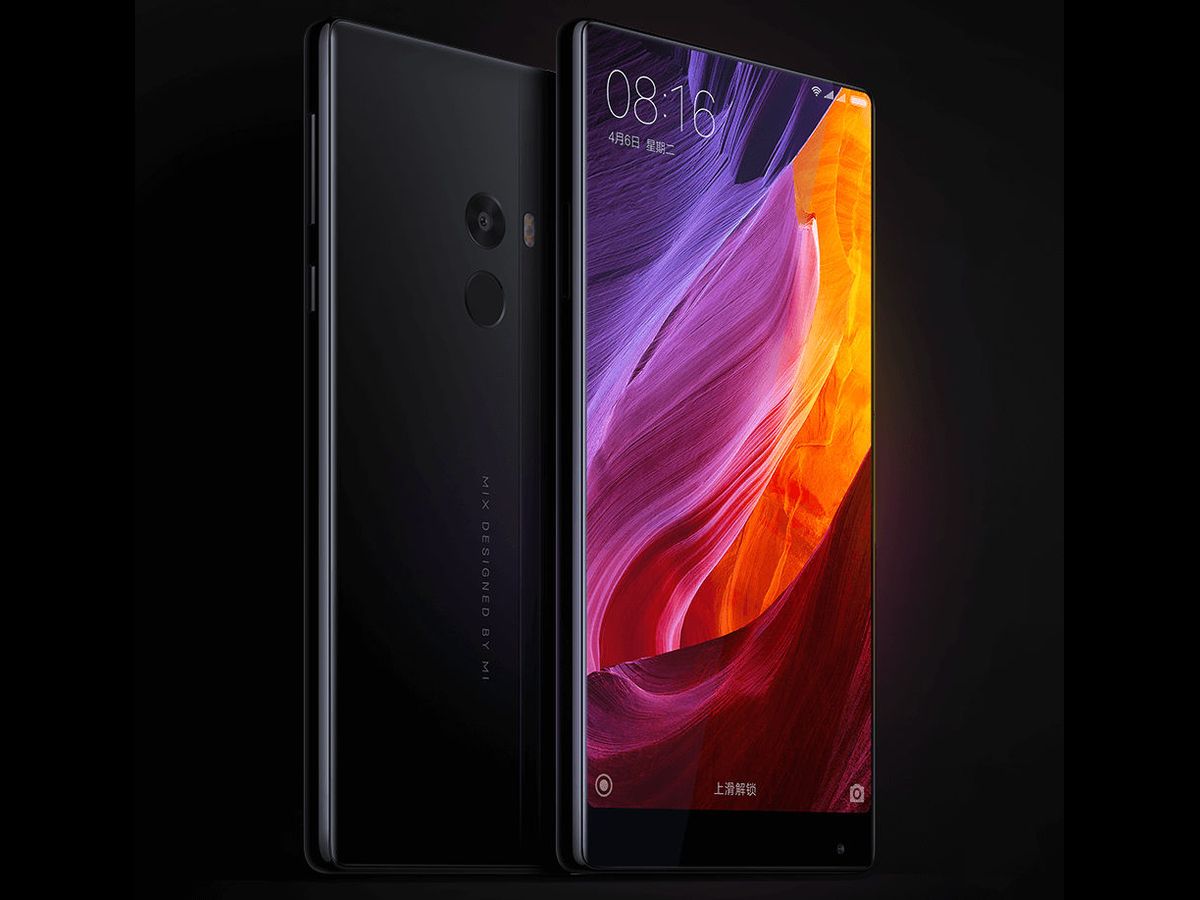
The Mi Mix display (IPS LCD) fills as much as 91.3% of the front surface of the smartphone, which is a record value for today.
This design required innovative technological solutions. So, Xiaomi Mi Mix is deprived of the classic front speaker, and sound transmission during a call is carried out through bone conduction technology (to the inner ear using the bones of the skull).
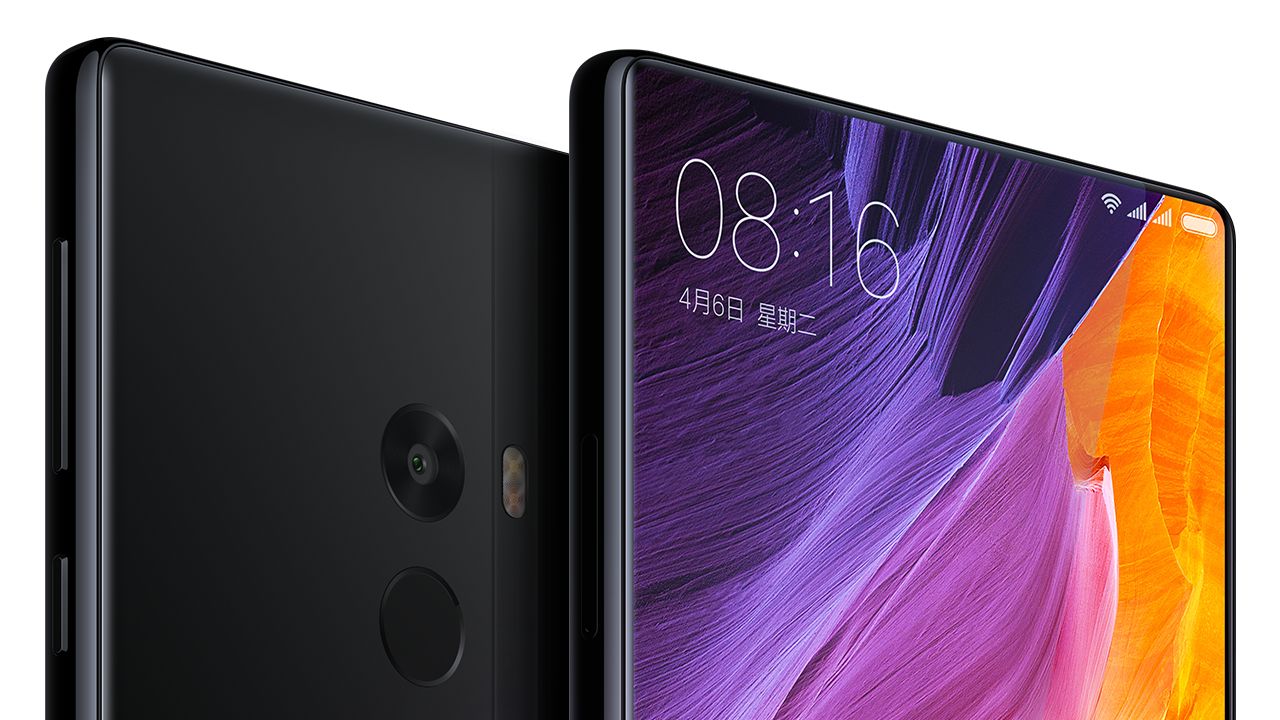
The front camera has migrated to a thin frame at the bottom of the screen, and the device has also lost hardware control buttons including “Home”, which was not previously observed in Xiaomi smartphones.
Mi Mix has a fingerprint scanner located on back cover under the camera. Of the mechanical elements, there are only volume and power buttons.
A piquant feature of Xiaomi Mi Mix is a fully ceramic case, and not just a back cover, like the Mi 5 released this spring. It is not yet clear what strength indicators such a design has, but if successful, we can count on a new trend.
The technology for the production of ceramic cases has not yet been sufficiently developed, so the company's representatives promise to produce no more than 10,000 pipes per month.
According to Xiaomi representatives, the new Mi Mix will be produced exclusively in black.
Interestingly, the already exclusive Xiaomi Mi Mix will have a special “jewelry” version with 18-carat gold-plated bezels around the screen. And this is not third-party customization, but “native”.
Specifications of Xiaomi Mi Mix
In terms of hardware, Mi Mix is a real uncompromising flagship smartphone based on Qualcomm Snapdragon 821 chipset.
Volume random access memory depending on the version, it is 4/6 Gb, and the internal flash drive is 128/256 Gb. Not without a “fly in the ointment”, however, the novelty does not have a MicroSD slot.
But there is a tray for two nano-SIM SIM cards, a 16 Mp main camera with phase detection autofocus and optical image stabilization, a 5 Mp front camera, 24-bit / 192 kHz audio stream playback, a modern interface USB Type-C and a very solid 4400 mAh battery with fast charging function Quick charge 3.0.
Also worth noting NFC support and proprietary contactless payment technology Xiaomi Mi Pay. The latter, however, is currently only available in China and is not relevant outside of it.
Works Xiaomi Mi Mix running the most modern mobile OS Android 7.0 Nougat with an adapted version of the original MIUI shell.
Cost of Xiaomi Mi Mix
Now it is worth talking about the price of the “question”. The exclusive smartphone will be available in two variants 4 Gb RAM + 128 Gb Flash and 6 Gb RAM + 256 Gb Flash.
The price of the first, according to representatives of Xiaomi, will be 3,499 yuan (about 515 US dollars) in the domestic Chinese market, the price of the second is 3,999 yuan or ~590 dollars. Not very much for such a unique innovative device.
So everything indicates that Xiaomi Mi Mix will be a really scarce product, for which queues will literally line up, and intermediaries will wind up a hefty margin.
Where and how to buy a new "mix"?
Accepting applications for pre-order Xiaomi Mi Mix starts on November 4th. It is expected that initially the smartphone will be sold only in the Celestial Empire, but everyone will be able to purchase it on Chinese marketplaces like AliExpress.
True, it is worth considering that we are talking about an exclusive model that will be released in a limited edition, so there may not be enough smartphones for everyone.
The smartphone looks like a concept, like the device of the future, which you can buy right now. The main merit in this belongs to the screen with minimal frames, which occupies almost the entire front of the case. This is made possible by amazing technology, but is such a smartphone convenient in everyday work? Let's try to answer this question.
Outwardly, Mi Mix is different from all the others. And other devices can be attractive, but this one evokes a special feeling. As already mentioned, it's all about the screen. It uses a 6.4-inch IPS LCD panel with an unusual 17:9 aspect ratio that takes up more than 90% of the front of the case. For comparison, the screen takes up 76%. The edges of the screen are smoothly rounded inside the case.
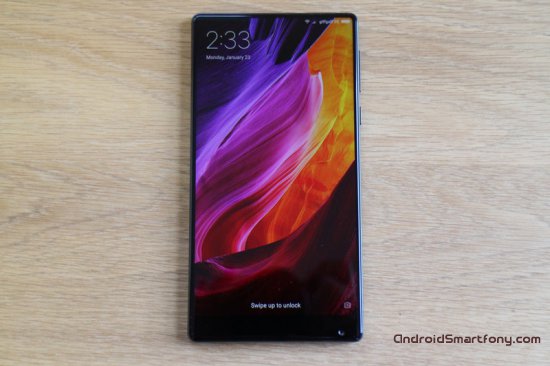

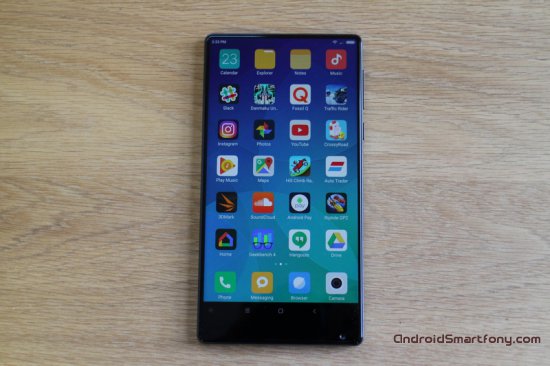
Otherwise, Mi Mix has a very simple form. Its minimalism doesn't catch your eye until you carefully examine the nuances, from Mix designed by Mi on the back to the complete absence of sensors and speakers on the front. The speaker is located behind the screen and uses a special isoelectric technology to transmit sound. Xiaomi did not use the usual distance sensor, using an ultrasonic module behind the screen. The smartphone not only looks good, but is also an impressive technical achievement.
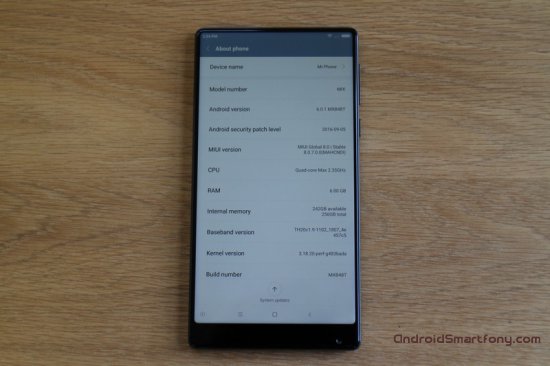
![]()
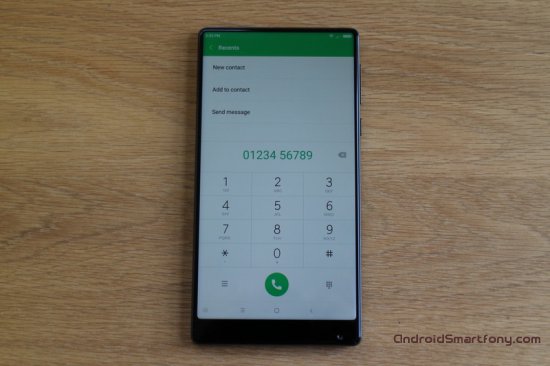
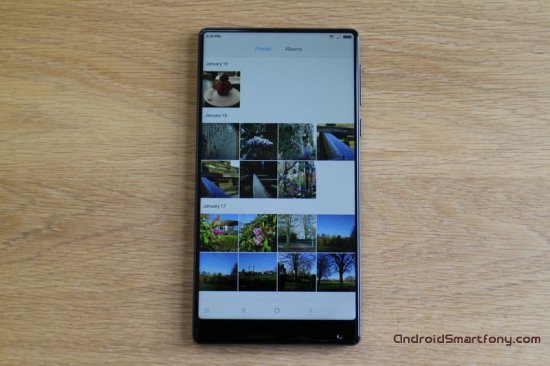
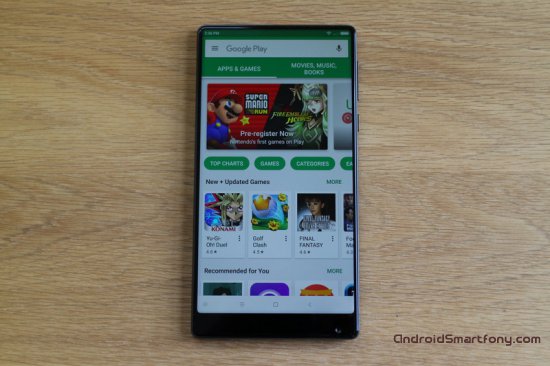
The build quality of the case is at the highest level. It is made of ceramic, not metal and glass. The sample in question was black, there is also a white version of the smartphone. The beauty is spoiled by numerous fingerprints that remain on the body, so it is advisable to carry a handkerchief with you to wipe it.
![]()
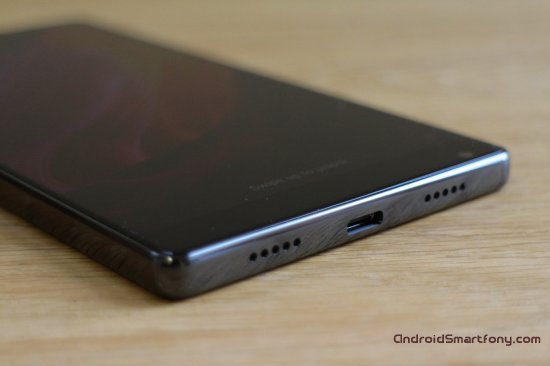
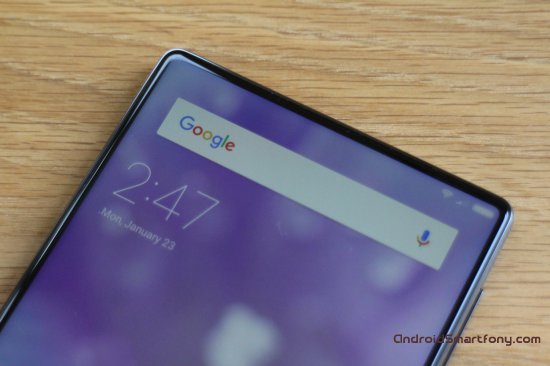
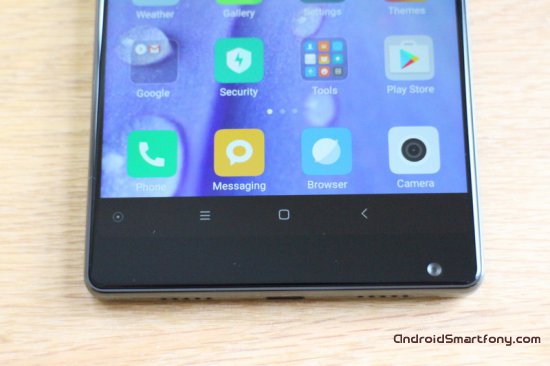

Fingerprints are not the only problem. Xiaomi Mi Mix is very slippery, as if constantly trying to escape from the user's hands. No matter how you try to hold him, he twists, slips out and rushes to freedom. The ceramic body offers no friction, no embossed patterns on it. Whether you're taking pictures or checking email, your smartphone slips out. For this reason, it is extremely important to put it in a case, otherwise the expensive device may be broken very soon.

![]()
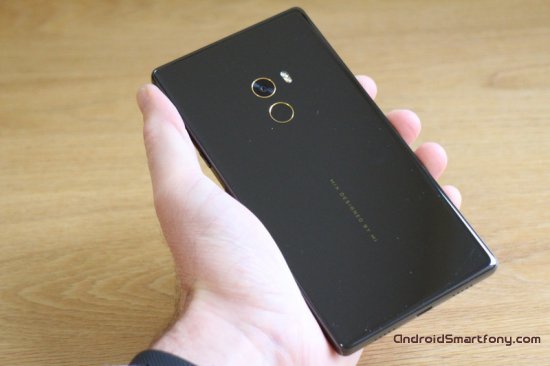



Xiaomi Mi Mix Performance
The reviewed version of the smartphone has 6 GB of RAM and a Snapdragon 821 processor, there is also a cheaper version with 4 GB of memory, without gold around the camera and fingerprint scanner.Snapdragon 821 is a fast processor that has proven itself well in smartphones like and. Here it shows itself no worse, allowing the operating system and applications to work quickly and smoothly, like games. Games are especially good on this big beautiful screen.
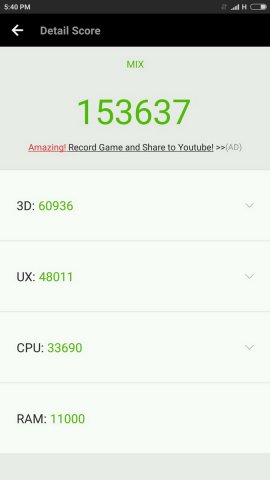
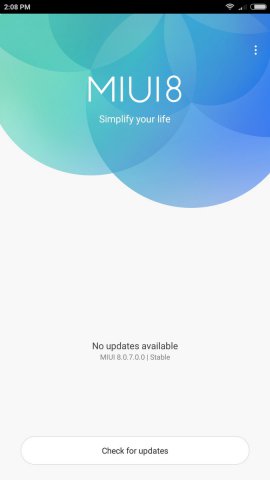



The developers chose an IPS LCD panel with a resolution of 1920 x 1080 pixels. This allows you to not consume battery power very quickly and is well suited for watching videos. By launching YouTube and expanding the video to full screen, you will fill it in its entirety, including curved needles.
In the AnTuTu 3D benchmark, the smartphone scored 153637 points, managing to enter the top five. The battery capacity here is 4400 mAh, which is a lot modern standards. As a result, with a typical use case, the charge lasts for two days.
Unfortunately, Xiaomi Mi Mix comes out on the operating system. The reason for the absence of the latter android versions Nougat can be considered a user interface Xiaomi MIUI. It makes big changes to Android - so big it doesn't even work payment system android pay.
MIUI 8 version installed, app store available Google Play. This means you don't have to deal with own shop Xiaomi and everything you need can be installed from the usual source. Initial setup takes certain time, but there are no problems.
The device has a number of pre-installed Xiaomi tools, including a QR code scanner, compass, voice recorder, contacts, mail, music, explorer and calendar. Xiaomi has installed its own dialer, messenger and browser. Those familiar with Nexus and Pixel smartphones will notice differences in the notification bar and settings menu; in addition, the icons of all applications are located on home screen, not in the application list.
Xiaomi has come up with some quality apps. Standard Browser works quickly, the weather app provides detailed information, the calendar is easy to use. If you don't like humble appearance icons in the MIUI interface, many graphic themes are available for installation. Settings allow you to change the appearance and functionality of the shell.
Many would prefer to run a pure version of Android, but MIUI is easy to use and nice to see. We'll have to put up with this shell from China, where Google services prohibited, it is more pleasant than shells from many Chinese manufacturers.
You can worry about the issue of security is not the most latest version Android, so I would like to believe that the smartphone will be updated to Android 7. Unfortunately, Xiaomi's update history is not the best, so this smartphone is not for those who want to receive monthly security updates.
Medium chamber
The resolution of the rear camera is 16 megapixels, the front 5 megapixels. The latter is not above the screen, but below it. That's what we're going to talk about first.Due to the screen size, the developers had to use a compact camera module. Its location is not the best, because you can miss your face when taking a selfie out of habit. To avoid trouble, when switching to the front camera, the smartphone tells you to rotate the device so that the camera is in the usual position, and the position of the camera application changes accordingly.
It's good when used Xiaomi cameras, but not if you work with Instagram, Snapchat and other photo apps. Then the camera can be covered with a hand or photos are taken at strange angles. If you turn your smartphone over, the app will not roll over with it, so you will see the wrong picture and it will become difficult to press the shutter button. The volume button can activate the shutter, but not in any application. The quality of photos on the front camera is average, although there are interesting filters and a beautification mode. Smart settings can greatly improve photos.
The rear camera is based on a Sony IMX318 sensor with f / 2.0 aperture and phase detection autofocus. There is no optical image stabilization, but there is electronic. Recently, a lot of smartphones have been released with double cameras, but even here you get good photos.
The camera aggressively uses the HDR mode, enhancing shadows and blue skies, some users would prefer not to use it.
The camera effectively blurs the background image, creating a great bokeh effect without the need for a second module. The same filters are available here as for the front camera, plus panoramic mode and manual shooting mode. As a result, the camera cannot be called the best, but it does not belong to the bad ones either.








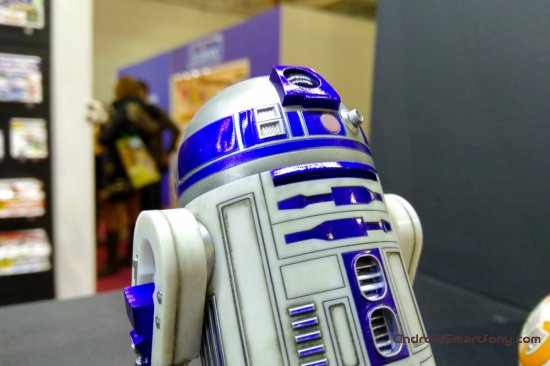



Calls and communications
Xiaomi uses piezoelectric technology behind the screen, the sound is transmitted through it. The effect is unusual, but there are no problems with quality or volume.The sound system works even better than traditional speakers. It doesn't matter if you hold your smartphone against your ear or not, any part of the screen produces the same volume and clarity.
The ultrasonic distance sensor does not work so well. Sometimes it turns off the screen when the smartphone is in front of the user's face, sometimes it accidentally activates applications. The screen does not dim when you cover it with your hand.
Advanced technology comes at a price, and this smartphone costs over $1,000 in the US. The reason is that it is produced in limited quantities.
The competitors of this device can be called
Overview of an almost frameless giant without a speaker
08.06.2017
Main Xiaomi specifications Mi Mix
| Screen | S-IPS, 6.4", 1080x2040, multi-touch 10 touches |
| Iron | 2.35 GHz, Qualcomm MSM8996 Snapdragon 821, 64 bit, 4 Kryo cores, Adreno 530 |
| Memory | RAM 6 GB, ROM 256 GB, no Micro-SD |
| Mobile Internet | LTE cat.12 600/100 Mbps HSDPA, HSUPA, TD-SCDMA EDGE |
| Mobile networks | LTE Bands 1-5,7,8,38-41 UMTS 850, 900, 1900, 2100 GSM 850, 900, 1800, 1900 CDMA 800 TD-SCDMA |
| Battery | Li-Ion, 4400 mAh, Quick charge 3.0 |
| Dimensions | 158.8 x 81.9 x 7.9mm |
| Weight | 209 g |
| Camera | 16 MP, flash, autofocus, f/2.0, PDAF, 4K video, Auto HDR frontal: 5 MP, f/2.2, 76° |
| Navigation | GPS, GLONASS, BeiDou |
| OS | Android 6.0 Marshmallow, MIUI 8 |
| SIM | 2 x Nano SIM |
| Price | 39990 RUB |
Smartphone category "wow". Huge, powerful, expensive, unusual. A 6.4" screen is almost like a tablet. But "without frames" around the screen - a frame on only one side, so the dimensions are not quite tablet-sized.
Top iron, sea of memory. The battery is great. "Ceramic case", whatever that means.
Alas, they could not fail. First, the camera. If in all other respects, including cost, Mi Mix claims to be the flagship, then the camera confidently lowers it from heaven to earth. Secondly, speaker. More precisely, its actual absence. Thirdly, by and large, it is not so frameless.
Price
Xiaomi Mi Mix is available in two varieties.
The younger one, with a "modest" 128 GB of flash memory, is not officially imported into our country. "Gray" devices can be found on sale at a price of 28 thousand rubles.
The older model can be bought in the official store for 39,990 rubles. In serious networks, it is not seen for sale. "Gray" devices can be found on sale somewhere in the thousands from 34x. Those. the difference in price compared to the official store is only 15%.
Equipment
Charger (black). USB Type-C cord (white). Nail-clip to remove the tray with SIM-cards. And - attention! - Leather Case!
A test device came to me, which had already passed through a number of testers. And the cover, to put it mildly, looks beaten by life. I put it on Mi Mix and was horrified. Oh yes, non-slip and practical. But the view - you're sorry ...
Appearance
| Weight | 209 g |
| Size | 158.8 x 81.9 x 7.9mm |
| Protection | No |
The main feature of Mi Mix is, of course, the screen. It is clear that the screen of any modern smartphone occupies most of the front surface. Here he occupies almost all of it ...
On three sides, the thickness of the frames is about 2.5 mm. Bottom - about 13 mm. In the official pictures, it seems that there are almost no frames at all. But this is a slight artistic exaggeration, for which Xiaomi has already thoroughly got it from journalists and reviewers. In reality, the frames are not so small, but due to big size screen, they really look very thin, so visually everything is in order, there is a frameless effect.
However, unusualness is achieved not even due to the thinness of the frames, but due to the almost complete absence of the upper frame. All smartphones are similar. On the sides of the frame is thinner, from top to bottom - thicker. And everything is placed on the upper-lower frames. Sometimes not posted. Sometimes the bottom frame is left blank. But it has historically been in smartphones - for symmetry, plus to make it more convenient to hold, and in general it happened that way.
Xiaomi decided to remove one of the top-bottom frames. And removed the top. On which the conversational speaker, front camera and light-proximity sensors are traditionally placed. And where, one wonders, do they go?
The front camera and light sensor were sent to a single wide frame, to the bottom. The camera was shoved into a corner, the sensor lives in the center. In the same place, in the center, there is also an LED.
Proximity sensor. We changed technology. Instead of infrared, it became ultrasonic. Ultrasonic sensors can work through the screen. Yes it works. But it doesn't feel as confident as traditional sensors. It is located in the expected place, at the top edge in the center.
The strangest thing is, of course, the conversational speaker, which is not. Quote from the official website: "Piezoceramic acoustics. During a conversation electrical signal converted into mechanical energy, causing a resonance in the metal frame of the smartphone, which generates sound waves that go straight to the ear."
Speaking in Russian, Mi Mix sounds all. It can be applied to the ear with both the screen and the back side. The effect is the same.
At the same time, the interlocutors are heard more or less normally. But you have to either turn the volume up, or the voice of the interlocutor will not be very pleasant. Worse another. In fact, it turned out to be a quiet speakerphone. When you cover the usual speaker of a regular smartphone with your ear, the entire voice of the interlocutor goes straight into your head, nothing is heard by others. Here the voice goes in all directions. And from a distance of a meter and a half of your interlocutor, everyone will hear perfectly.
It is necessary to understand the following. Both ceramic acoustics and ultrasonic sensor are fully working technologies. But inferior to traditional ones. And they are used in Mi Mix not because these technologies are fashionable and cool, but because you need to somehow get out of the situation in which Xiaomi themselves have driven themselves away by abandoning the top frame. Although, honestly, it would be better if they just moved the speaker to the back surface. There is definitely enough space there.
Stop whining. The Mi Mix looks, of course, just wow. Refined black color, gold rims around the camera and finger sensor. Attention attracts, respect inspires. It's hard, really. Doesn't fit in pockets. Gloss collects fingerprints. And he's slippery too. I don't seem to want to whine? Oh.
By the way, they say that the gold of the rims is real. 18 carat. No, this does not mean that there is 18 carats of gold (i.e. 3.6 grams). This only means that the material of the rim is 75% gold.
The case, of course, is non-separable. The assembly, of course, is excellent.
Case material - "ceramics". No, not clay, there are a lot of different ceramics now. According to tactile sensations - glass with glass. But it sounds like! Ceramic Smartphone! That's nice - the material seems to be very strong, in the sense that it is not scratchy. As for shock resistance, I'm not sure. I was afraid to check.
Boring details about appearance
Rear Camera, flash, fingerprint sensor. The sensor and the camera are made of the same size and are located close to each other. However, it is not too difficult not to miss. You just need to feel for the sensor by moving your finger from about the middle of the back up.
Top. Audio output 3.5 mm and two holes from two microphones.
Bottom. USB Type-C output. The speaker is one piece. The second lattice is fake. Well, or behind it hides the third microphone.
The buttons are sent to the right side.
Tray for SIM-cards (Nano-SIM) - on the left.
Entrails (iron)
| AnTuTu | 115895 (v6.2.7) |
| AnTuTu | 67395 (v5.7.1) |
| Chipset | Qualcomm Snapdragon 821 |
| Nuclei | 2 x Kryo 2.35 GHz 2 x Kryo 2.20 GHz |
| GPU | Adreno 530 |
| RAM | 6 GB |
| ROM | 256 GB |
| Micro SD | No |
Apart from a couple of platitudes, there is nothing to say. Powerful processor and a lot of memory. Both operational and flash. All.
Lots of sensors. Barometer, accelerometer, compass, gyroscope. I already mentioned light and proximity sensors.
The fingerprint sensor also did not let us down, clear and competent. Although it is not always possible to get into it quickly.
Communication with the outside world
For complete happiness, only LTE Band 20 is missing. Otherwise, everything is fine.
Screen
The screen is great, but there are still a couple of questions about it.
Firstly, why was it necessary to make such a weak minimum brightness? However, this is a trifle. The second point is more interesting.
Random clicks. In portrait orientation, everything is fine. But in the album they happened quite regularly. In toys. Naturally, on the side where the narrow frame.
Well, you should pay attention to the screen resolution. It is a little non-standard.
Otherwise, I repeat, everything is fine with the screen. Bright, beautiful, with an excellent oleophobic coating.
Operating system and other software
Everything is fine. Russified, stable, etc. No problem. Facebook was preinstalled, but removed without problems.
I liked the ability to swipe at any time to remove the on-screen buttons. Comfortable. Here they are, but now they are gone.
I did not like how the same on-screen buttons are drawn directly on top of the picture. Trying to get out of the toy - try to get into the "Back" button, which is not visible. Do you see it in this screenshot?
Battery
Battery capacity - 4400 mAh. The battery test results are excellent - 183% of my conventional benchmark. It is only theoretically possible to walk away in a day. Particularly pleased that there is no particular failure in the GPS tests. They are usually the weak link.
Xiaomi Mi Mix as a flashlight
Flashlight from the flash turned out to be very decent. 8 lux from a distance of 180 centimeters is a good result.
Information about the make, model, and alternative names of a particular device, if any.
Design
Information about the dimensions and weight of the device, presented in different units of measurement. Used materials, suggested colors, certificates.
| Width Width information refers to the horizontal side of the device in its standard orientation during use. | 81.9 mm (millimeters) 8.19 cm (centimeters) 0.27 ft 3.22in |
| Height Height information refers to the vertical side of the device in its standard orientation during use. | 158.8 mm (millimeters) 15.88 cm (centimeters) 0.52 ft 6.25in |
| Thickness Information about the thickness of the device in different units measurements. | 7.9 mm (millimeters) 0.79 cm (centimeters) 0.03 ft 0.31in |
| Weight Information about the weight of the device in different units of measurement. | 209 g (grams) 0.46 lbs 7.37oz |
| Volume Approximate volume of the device, calculated from dimensions provided by the manufacturer. Refers to devices with the shape of a rectangular parallelepiped. | 102.75 cm³ (cubic centimeters) 6.24 in³ (cubic inches) |
| Colors Information about the colors in which this device is offered for sale. | Black White |
| Housing materials The materials used to make the body of the device. | Ceramics |
SIM card
The SIM card is used in mobile devices to store data that certifies the authenticity of mobile service subscribers.
Mobile networks
A mobile network is a radio system that allows multiple mobile devices to communicate with each other.
| GSM GSM (Global System for Mobile Communications) is designed to replace the analogue mobile network (1G). For this reason, GSM is often referred to as a 2G mobile network. It is enhanced by the addition of GPRS (General Packet Radio Services) and later EDGE (Enhanced Data rates for GSM Evolution) technologies. | GSM 850 MHz GSM 900 MHz GSM 1800 MHz GSM 1900 MHz |
| CDMA CDMA (Code-Division Multiple Access) is a channel access method used in communications in mobile networks. Compared with other 2G and 2.5G standards like GSM and TDMA, it provides more high speeds data transfer and connectivity more consumers at the same time. | CDMA 800 MHz |
| TD-SCDMA TD-SCDMA (Time Division Synchronous Code Division Multiple Access) is a 3G standard for mobile networks. It is also called UTRA/UMTS-TDD LCR. It is developed as an alternative to the W-CDMA standard in China by the China Academy of Telecommunication Technology, Datang Telecom and Siemens. TD-SCDMA combines TDMA and CDMA. | TD-SCDMA 1880-1920 MHz TD-SCDMA 2010-2025 MHz |
| UMTS UMTS is short for Universal Mobile Telecommunications System. It is based on the GSM standard and belongs to 3G mobile networks. Developed by 3GPP and its biggest advantage is to provide more speed and spectral efficiency with W-CDMA technology. | UMTS 850 MHz UMTS 900 MHz UMTS 1900 MHz UMTS 2100 MHz |
| LTE LTE (Long Term Evolution) is defined as a technology fourth generation(4G). It is developed by 3GPP based on GSM/EDGE and UMTS/HSPA to increase the capacity and speed of wireless mobile networks. The subsequent development of technologies is called LTE Advanced. | LTE 850 MHz LTE 900 MHz LTE 1700/2100 MHz LTE 1800 MHz LTE 1900 MHz LTE 2100 MHz LTE 2600 MHz LTE-TDD 1900 MHz (B39) LTE-TDD 2300 MHz (B40) LTE-TDD 2500 MHz (B41) LTE-TDD 2600 MHz (B38) |
Mobile technologies and data rates
Communication between devices in mobile networks is carried out through technologies that provide different data rates.
Operating system
The operating system is the system software that manages and coordinates the operation of the hardware components in the device.
SoC (System on a Chip)
System on a chip (SoC) includes all the most important hardware components of a mobile device in one chip.
| SoC (System on a Chip) A system on a chip (SoC) integrates various hardware components such as a processor, graphics processor, memory, peripherals, interfaces, etc., as well as the software necessary for their operation. | Qualcomm Snapdragon 821 MSM8996 Pro |
| Technological process Information about the technological process by which the chip is made. The value in nanometers measures half the distance between the elements in the processor. | 14 nm (nanometers) |
| Processor (CPU) The main function of the processor (CPU) mobile device is the interpretation and execution of instructions contained in software applications. | 2x 2.35 GHz Kryo, 2x 2.0 GHz Kryo |
| Processor bit depth The bit depth (bits) of a processor is determined by the size (in bits) of registers, address buses, and data buses. 64-bit processors have more high performance compared to 32-bit processors, which for their part are more productive than 16-bit processors. | 64 bit |
| Instruction Set Architecture Instructions are commands by which the software sets/controls the operation of the processor. Information about the instruction set (ISA) that the processor can execute. | ARMv8-A |
| First level cache (L1) Cache memory is used by the processor to reduce access time to more frequently accessed data and instructions. L1 (level 1) cache is small and much faster than both system memory and other cache levels. If the processor does not find the requested data in L1, it continues to look for them in the L2 cache. With some processors, this search is performed simultaneously in L1 and L2. | 32 kB + 32 kB (kilobytes) |
| Second level cache (L2) L2 (level 2) cache is slower than L1, but in return it has a larger capacity, allowing more data to be cached. It, like L1, is much faster than system memory (RAM). If the processor does not find the requested data in L2, it continues to look for it in the L3 cache (if available) or RAM. | 1536 KB (kilobytes) 1.5 MB (megabytes) |
| Number of processor cores The processor core executes program instructions. There are processors with one, two or more cores. Having more cores increases performance by allowing many instructions to be executed in parallel. | 4 |
| Processor clock speed The clock speed of a processor describes its speed in terms of cycles per second. It is measured in megahertz (MHz) or gigahertz (GHz). | 2350 MHz (megahertz) |
| Graphics Processing Unit (GPU) Graphics Processing Unit (GPU) handles calculations for various 2D/3D graphic applications. In mobile devices, it is used most often by games, consumer interface, video applications, etc. | Qualcomm Adreno 530 |
| Clock frequency GPU Speed is the clock speed of the GPU and is measured in megahertz (MHz) or gigahertz (GHz). | 653 MHz (megahertz) |
| The amount of random access memory (RAM) Random access memory (RAM) used operating system and all installed applications. Data stored in RAM is lost when the device is turned off or restarted. | 4 GB (gigabytes) |
| Type of random access memory (RAM) Information about the type of random access memory (RAM) used by the device. | LPDDR4 |
| Number of RAM channels Information about the number of RAM channels that are integrated into the SoC. More channels means higher data rates. | dual channel |
| RAM frequency The frequency of RAM determines its speed, more specifically, the speed of reading / writing data. | 1866 MHz (megahertz) |
Built-in memory
Each mobile device has a built-in (non-removable) memory with a fixed amount.
Screen
The screen of a mobile device is characterized by its technology, resolution, pixel density, diagonal length, color depth, etc.
| Type/technology One of the main characteristics of the screen is the technology by which it is made and on which the image quality of information directly depends. | IPS |
| Diagonal For mobile devices, the screen size is expressed in terms of its diagonal length, measured in inches. | 6.4in 162.56 mm (millimeters) 16.26 cm (centimeters) |
| Width Approximate Screen Width | 2.99in 76.06 mm (millimeters) 7.61 cm (centimeters) |
| Height Approximate Screen Height | 5.66in 143.67 mm (millimeters) 14.37 cm (centimeters) |
| Aspect Ratio The ratio of the dimensions of the long side of the screen to its short side | 1.889:1 |
| Permission Screen resolution indicates the number of pixels vertically and horizontally on the screen. Higher resolution means sharper image detail. | 1080 x 2040 pixels |
| Pixel Density Information about the number of pixels per centimeter or inch of the screen. Higher density allows information to be shown on the screen in clearer detail. | 361 ppi (pixels per inch) 141ppm (pixels per centimeter) |
| Color depth Screen color depth reflects the total number of bits used for the color components in a single pixel. Information about the maximum number colors that the screen can show. | 24 bit 16777216 flowers |
| Screen area Approximate percentage of screen space on the front of the device. | 84.29% (percentage) |
| Other characteristics Information about other functions and features of the screen. | capacitive Multitouch Scratch resistance |
| Display manufacturer - AU Optronics / Sharp 1300:1 contrast ratio 500 cd/m² 94% NTSC |
Sensors
Different sensors perform different quantitative measurements and convert physical indicators into signals that are recognized by the mobile device.
Main camera
The main camera of a mobile device is usually located on the back of the case and is used for taking photos and videos.
| Sensor Model | OmniVision OV16880 |
| Sensor type | PureCel |
| Sensor size | 4.74 x 3.56 mm (millimeters) 0.23in |
| Pixel size | 1.029 µm (micrometers) 0.001029 mm (millimeters) |
| crop factor | 7.29 |
| ISO (light sensitivity) ISO values determine the light sensitivity level of the photosensor. A lower value means weaker light sensitivity and vice versa - higher values mean higher light sensitivity, i.e. better ability of the sensor to work in low light conditions. | 100 - 3200 |
| Diaphragm | f/2.0 |
| Focal length | 4.26 mm (millimeters) 31.07 mm (millimeters) *(35 mm / full frame) |
| Flash type The most common types of flashes in mobile devices cameras are LED and xenon flashes. LED flashes give a softer light and, unlike brighter xenon flashes, are also used for video shooting. | Double LED |
| Image Resolution One of the main characteristics of mobile device cameras is their resolution, which indicates the number of pixels in the horizontal and vertical direction of an image. | 4608 x 3456 pixels 15.93 MP (megapixels) |
| Video resolution Information about the maximum supported resolution for video recording by the device. | 3840 x 2160 pixels 8.29 MP (megapixels) |
Information about the maximum number of frames per second (fps) supported by the device when shooting video at the maximum resolution. Some of the main standard shooting and video playback speeds are 24p, 25p, 30p, 60p. | 30 fps (frames per second) |
| Characteristics Information about other software and hardware features related to the main camera and improving its functionality. | autofocus Burst shooting digital zoom Digital Image Stabilization geo tags panoramic shooting HDR shooting Touch focus Face recognition Adjusting the white balance ISO setting Exposure compensation Self-timer Scene Selection Mode |
| Phase detection 720p@120fps |
Additional camera
Additional cameras are usually mounted above the screen of the device and are mainly used for video calls, gesture recognition, etc.
| Sensor Model Information about the manufacturer and model of the photo sensor used in the device's camera. | OmniVision OV5675 |
| Sensor type Digital cameras use photo sensors to take pictures. The sensor, as well as the optics, is one of the main factors in the quality of a camera in a mobile device. | PureCel |
| Sensor size Information about the size of the photosensor used in the device. Typically, cameras with a larger sensor and lower pixel density offer more high quality images despite the lower resolution. | 2.98 x 2.21 mm (millimeters) 0.15in |
| Pixel size The smaller pixel size of the photosensor allows more pixels to be used per unit area, thus increasing resolution. On the other hand, a smaller pixel size can have a negative impact on image quality when high levels light sensitivity (ISO). | 1.151 µm (micrometers) 0.001151 mm (millimeters) |
| crop factor The crop factor is the ratio between the size of a full-frame sensor (36 x 24mm, equivalent to a frame of standard 35mm film) and the size of the device's photosensor. The number shown is the diagonal ratio of the full-frame sensor (43.3 mm) and the photosensor specific device. | 11.66 |
| Diaphragm Aperture (f-number) is the size of the aperture opening that controls the amount of light reaching the photosensor. A lower f-number means the aperture is larger. | f/2.0 |
| Focal length Focal length is the distance in millimeters from the photosensor to the optical center of the lens. There is also an equivalent focal length that provides the same field of view with a full frame camera. | 4.6 mm (millimeters) 53.66 mm (millimeters) *(35 mm / full frame) |
| Image Resolution Information about the maximum resolution of the secondary camera when shooting. In most cases, the resolution of the secondary camera is lower than that of the main camera. | 2592 x 1944 pixels 5.04 MP (megapixels) |
| Video resolution Information about the maximum supported video resolution additional camera. | 1920 x 1080 pixels 2.07 MP (megapixels) |
| Video - frame rate/frames per second. Information about the maximum number of frames per second (fps) supported by the optional camera when shooting video at the maximum resolution. | 30 fps (frames per second) |
Audio
Information about the type of speakers and audio technologies supported by the device.
Radio
The radio of the mobile device is a built-in FM receiver.
Location determination
Information about navigation and location technologies supported by the device.
WiFi
Wi-Fi is a technology that provides wireless communication for short distance data transmission between different devices.
Bluetooth
Bluetooth is a standard for secure wireless data transfer between different types of devices over short distances.
USB
USB (Universal Serial Bus) is an industry standard that allows different electronic devices to communicate.
Headphone jack
This is an audio connector, which is also called an audio jack. The most widely used standard in mobile devices is the 3.5mm headphone jack.
Connecting devices
Information about other important connection technologies supported by the device.
Browser
A web browser is a software application for accessing and viewing information on the Internet.
| Browser Information about some of the key features and standards supported by the device's browser. | HTML HTML5 CSS 3 |
Audio file formats/codecs
Mobile devices support various audio file formats and codecs that store and encode/decode digital audio data, respectively.
Video file formats/codecs
Mobile devices support various video file formats and codecs, which store and encode/decode digital video data, respectively.
Battery
Mobile device batteries differ from each other in their capacity and technology. They provide the electrical charge they need to function.
| Capacity The capacity of a battery indicates the maximum charge it can store, measured in milliamp-hours. | 4400 mAh (milliamp-hours) |
| Type The type of battery is determined by its structure and, more specifically, by the chemicals used. Exist different types batteries, with lithium-ion and lithium-ion polymer batteries most commonly used in mobile devices. | Li-polymer (Li-polymer) |
| Adapter output power Information about the strength of the electric current (measured in amperes) and electric voltage(measured in volts) that supplies Charger(output power). Higher power output ensures faster battery charging. | 5 V (volts) / 2.5 A (amps) 9 V (volts) / 2 A (amps) 12 V (volts) / 1.5 A (amps) |
| Fast charging technology Fast charging technologies differ from each other in terms of energy efficiency, maintained output power, control over the charging process, temperature, etc. The device, battery and charger must be compatible with fast charging technology. | Qualcomm Quick Charge 3.0 |
| Characteristics Information about some additional features of the device's battery. | fast charging Fixed |
The bezels around the display are a real stumbling block for smartphone manufacturers: everyone constantly boasts about the percentage of the bezel area that the display occupies, and also resorts to not the most pleasant tricks in an attempt to visually increase this very area. Recall at least the infamous black frame for a number of last year's (and not only) smartphones.
But there are more radical and honest examples. For example, the Sharp company, which has not been supplying smartphones to markets other than its native Japanese for a long time, in 2014 released the Aquos Crystal model, in which the screen was really almost devoid of frames on three sides - it looked impressive, but the smartphone is nothing else. stood out and did not become particularly popular. But the idea did not sink into oblivion with this device - the guys from Xiaomi, who had not been distinguished by original thinking, suddenly remembered it and used it in their Mi MIX, and provided it with a very impressive technical stuffing.
This is the real flagship of the Mi family - not only in a ceramic body with a huge 6.4-inch display with a resolution of 2040 × 1080 pixels, but also with a Qualcomm Snapdragon 821 platform, 4 or 6 GB of RAM, 128 or 256 GB of flash memory and a solid 4400 mAh battery. The camera is somewhat out of this range - a single 16-megapixel module is used here.
How generally Mi MIX is suitable for everyday use? Is it a geek toy or a fully functional gadget? Did he manage to bend during testing? In general, asking yourself questions at the beginning of the review is a bad form, but here they climb onto the tongue. When talking about a smartphone, “not like everyone else”, you can’t get rid of them.
⇡ Specifications
| Xiaomi Mi MIX | Xiaomi Mi5s Plus | Huawei Mate 9 | LG V20 | Google Pixel | |
|---|---|---|---|---|---|
| Display | 6.4" IPS 2040 × 1080 dots, 363 ppi, capacitive multi-touch |
5.7 inches, IPS, 1920 × 1080 pixels, 386 ppi, capacitive multi-touch | 5.9" IPS 1920 × 1080 dots, 373 ppi, capacitive multi-touch |
5.7" IPS 2560 × 1440 dots, 515 ppi, capacitive multi-touch |
5 inches, AMOLED, 1920 × 1080 pixels, 441 ppi, capacitive multi-touch |
| Protective glass | yes, manufacturer unknown | Corning Gorilla Glass 4 | Corning Gorilla Glass 4 | Corning Gorilla Glass 4 | |
| CPU | Qualcomm Snapdragon 821 MSM8996 (Dual Kryo Cores @ 2.35GHz + Dual Kryo Cores @ 1.36GHz) | HiSilicone Kirin 960 (quad-core ARM Cortex-A73, 2.4GHz + quad-core ARM Cortex-A53, 1.8GHz) | Qualcomm Snapdragon 820 MSM8996 (Dual Kryo Cores @ 2.15GHz + Dual Kryo Cores @ 1.36GHz) | Qualcomm Snapdragon 821 (two Kryo cores clock frequency 2.15GHz + dual Kryo cores @ 1.6GHz) | |
| Graphic controller | Adreno 530, 624 MHz | Adreno 530, 624 MHz | ARM Mali-G71 MP8, 850 MHz | Adreno 530, 624 MHz | Adreno 530, 650 MHz |
| Operational memory | 4/6 GB | 4/6 GB | 4 GB | 4 GB | 4 GB |
| Flash memory | 128/256 GB | 64/128 GB | 64 GB | 32/64 GB | 32/128 GB |
| Map support memory | No | No | There is | There is | No |
| Connectors | USB Type-C, mini jack 3.5 mm | USB Type-C, mini jack 3.5 mm | USB Type-C, mini jack 3.5 mm | USB Type-C | USB Type-C, mini jack 3.5 mm |
| SIM cards | two nano-SIMs | two nano-SIMs | one nano-SIM / two nano-SIMs | two nano-SIMs | one nano SIM |
| Cellular connection 2G | GSM 850 / 900 / 1800 / 1900 MHz | GSM 850 / 900 / 1800 / 1900 MHz | GSM 850 / 900 / 1800 / 1900 MHz | GSM 850 / 900 / 1800 / 1900 MHz | |
| Cellular connection 3G | HSDPA 850/900/1900/2100 MHz | HSDPA 850/900/1900/2100 MHz | HSDPA 850/900/1900/2100 MHz | HSDPA 850/900/1900/2100 | HSDPA 800/850/900/1700/1900/2100 MHz |
| Cellular 4G | LTE Cat. 12 (up to 600 Mbps): bands 1, 3, 4, 5, 7, 9, 38, 39, 40, 41 | LTE Cat. 12 (up to 600 Mbps): bands 1, 3, 5, 7, 38, 39, 40, 41 | LTE Cat. 12 (up to 600 Mbps), bands 1, 2, 3, 4, 5, 7, 8, 9, 12, 17, 18, 19, 20, 26, 28, 29, 38, 39, 40, 41 | LTE Cat. 7 (up to 300 Mbps): bands 1, 2, 3, 4, 5, 7, 8, 18, 19, 26, 28, 38, 40, 41 | LTE Cat. 12 (up to 600 Mbps): Ranges vary by version (US or Europe); Russian frequencies, except for band 31, are supported in each of the versions |
| WiFi | 802.11a/b/g/n/ac | 802.11a/b/g/n/ac | 802.11a/b/g/n/ac | 802.11a/b/g/n/ac | 802.11a/b/g/n/ac |
| Bluetooth | 4.2 | 4.2 | 4.2 | 4.2 | 4.2 |
| NFC | There is | There is | There is | There is | There is |
| Navigation | GPS, A-GPS, GLONASS, BeiDou | GPS, A-GPS, GLONASS, Galileo, BeiDou | GPS, A-GPS, GLONASS | GPS, A-GPS, GLONASS | |
| Sensors | Light, proximity, accelerometer/gyroscope, magnetometer (digital compass), IR sensor | Illumination, proximity, accelerometer/gyroscope, magnetometer (digital compass) | Light, proximity, accelerometer/gyroscope, magnetometer (digital compass), barometer | ||
| Fingerprint's scanner | There is | There is | There is | There is | There is |
| Main camera | 16 MP, ƒ/2.0, phase detection autofocus, dual LED flash | Dual module, 13 MP, ƒ / 2, phase detection autofocus, dual LED flash | Dual module, 20 + 12 MP, ƒ / 2.2, hybrid autofocus, optical stabilization, dual LED flash | 16 MP, ƒ/1.8, laser autofocus, LED flash; 8 MP, f/2.4, widescreen | 12 MP, ƒ/2.0, hybrid autofocus, LED flash, 4K video recording |
| Front-camera | 5 MP, fixed focus | 4 MP, fixed focus | 8 MP, autofocus | 5 MP, fixed focus | 8 MP, fixed focus |
| Nutrition | Non-removable battery: 16.7 Wh (4400 mAh, 3.8 V) | 14.44 Wh non-removable battery (3800 mAh, 3.8 V) | Non-removable battery: 15.2 Wh (4000 mAh, 3.8 V) | Removable 12.2 Wh battery (3200 mAh, 3.8 V) | 10.5 Wh non-removable battery (2770 mAh, 3.8 V) |
| Size | 158.8×81.9×7.9mm | 154.6×77.7×7.95mm | 156.9×78.9×7.9mm | 159.7×78.1×7.6mm | 143.8×69.5×8.5mm |
| Weight | 209 grams | 168 grams | 190 grams | 174 grams | 143 grams |
| Protection corps | No | No | No | No | No |
| operating room system | Android 6.0 Marshmallow, MIUI skin | Android 7.0 Nougat, EMUI shell | Android 7.0 Nougat, LG UX skin | Android 7.1 Nougat with Pixel Launcher skin | |
| Actual price | 48,000-50,000 rubles (in the BigGik store) | 23-27 000 rubles | from 42 000 rubles | 45 000 rubles | $649 / $749 |
⇡ Design, ergonomics and software
Xiaomi Mi MIX successfully performs its main task all the time - it forces almost every gadget lover to carefully examine themselves and click their tongues with interest. In fact, no - no one clicked their tongue in front of me, but such a stir in recent years was caused only by new iPhones. The effect is really impressive. For example, before Mi MIX, I have consistently tested LeEco Le Pro3, Xiaomi Mi5s Plus and Huawei Mate 9 - great smartphones, but almost indistinguishable from each other. Everyone is trying to add some of their spices, but in general the recipe is the same. And then he changed - the triumphant return of the black square!

The Mi MIX color is not called Jet Black - but it is, in fact, it is. The most fashionable color of the year, brought back from the past, of course, by Apple. On the front of the completely black MIX glass panel, nothing stands out except for a tiny peephole front camera, located in the lower right corner - there was nowhere else to place it. Behind and on the sides - a ceramic surface, like on Mi5, only completely black. It shines nobly, like the lid of a piano, but it also gets dirty quickly. Moreover, doubly unpleasant news - for some reason, the oleophobic coating of the front panel, which usually works excellently with Xiaomi, behaves somehow wrong and collects fingerprints very actively. Wipe your smartphone frequently. Too often.
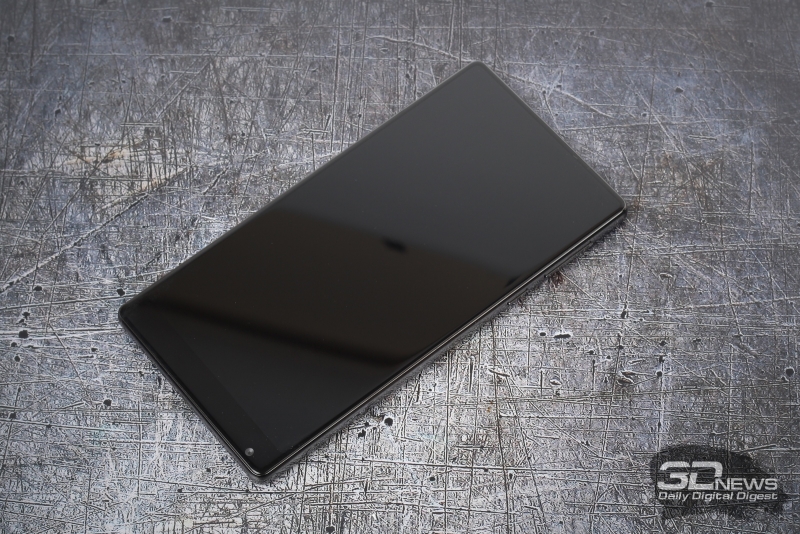
But as soon as you turn it on - and here it is, the moment of triumph for the owner: almost the entire front panel lights up, entirely. The side and top frames are minimal, their thickness really tends to zero. And what's more - the area under the screen is also quite small, unlike the case of the same Sharp Aquos Crystal. And like a cherry on this cake of 90% engagement of the front panel under the display - the virtual navigation keys placed on it too smaller, than usual. The user has almost all 6.4 inches.
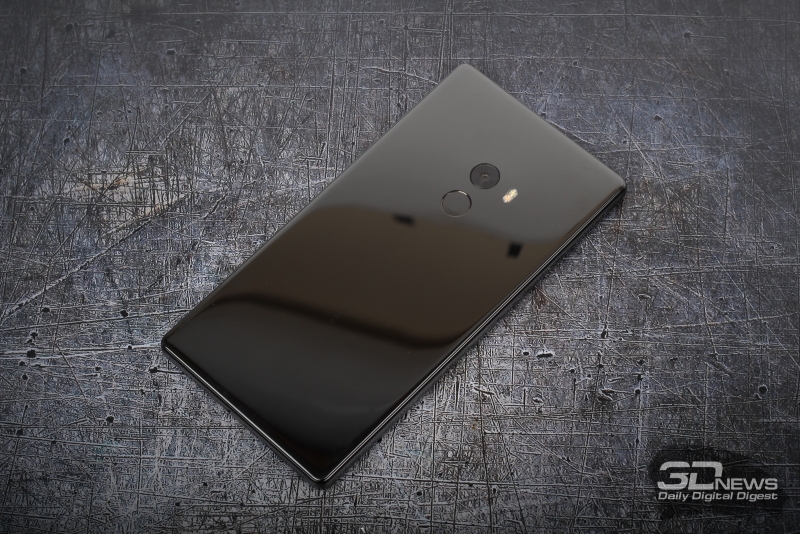
The inscription on the back cover "Mix Designed by Mi" does not look like a mockery - it's really beautiful and, importantly, original a smartphone that is unlike anything we are used to.


It is absolutely impossible to use this smartphone with one hand - and moreover, without a case it is even dangerous. The case is very slippery - if you hold it on your fingertips, dropping Mi MIX is easy. It is worth grabbing the edges with one hand, and with the other work with the display. However, it feels similar to the Huawei Mate 9 or Xiaomi Mi5s Plus - smartphones with 5.7 and 5.9-inch displays, respectively. So there is a practical sense from framelessness - further increase in diagonal without turning the device into a monster like ASUS Zenfone 3 Ultra. Mi MIX dimensions - 158.8 × 81.9 × 7.9 mm. For comparison: the dimensions of Mi5s Plus are 154.6 × 77.7 × 7.95 mm. Not bad for a device with a 0.7-inch larger display, right? But, of course, it is much heavier - 209 grams versus 168. And this is noticeable not only in the hand, but also when carried in your pocket.

Xiaomi Mi MIX, top: mini-jack (3.5 mm) for headphones / headset and two microphones
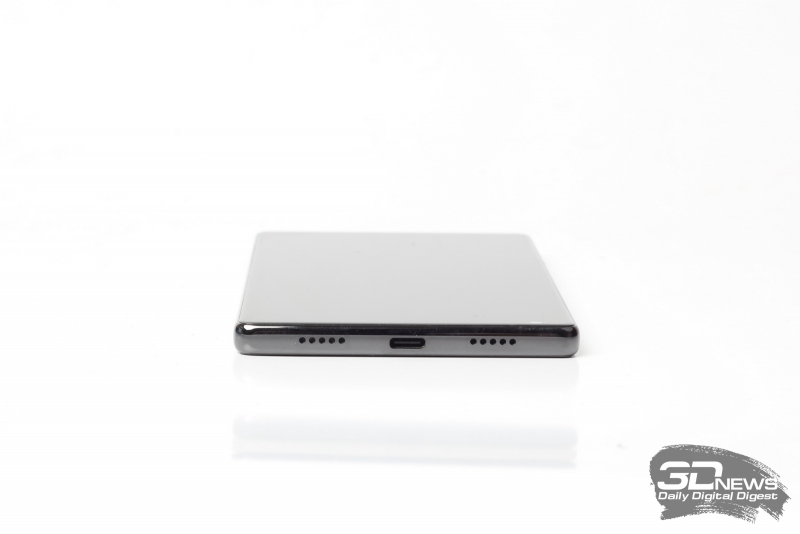
I have already said about the advantages of a frameless design - it's time to talk about the cons. The fragility of the design, on the one hand, is obvious - it is very easy to break the display of such a device. On the other hand, large frames do not save the screen at all - now all smartphones are fighting from falling even from a small height, except for specially protected ones (like Moto X Force / Moto Z Force or all sorts of "SUVs" in the manner of CAT). I wouldn't worry about this. But the number of false clicks in my pocket increases critically - because of this, during the week and a half of testing, I experienced several awkward moments. Accidental touches on the edges of the display are also inevitable, especially if you do try to use the MIX with one hand - and this is another reason not to do so.
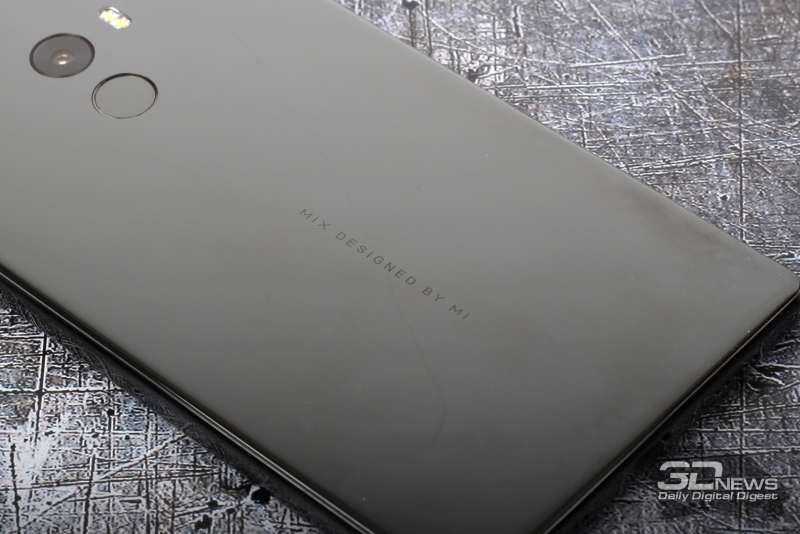
But I can’t say that Mi MIX is somehow catastrophically less convenient than its counterparts with normal frames. This is a special smartphone, unusual in operation and slightly embarrassing with false positives of the display sensor, but it did not leave any additional negative sensations from use.
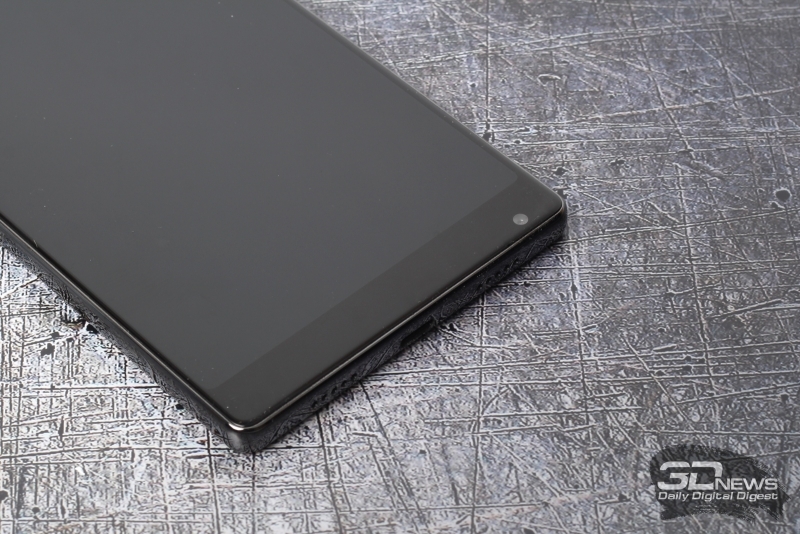
Apart from the location of the selfie camera, there are no other surprises in the placement of functional elements in Mi MIX - the charging port and speaker on the bottom, the mini-jack and microphone on the top, the power and volume keys on the right. Is that the infrared port for some reason disappeared.
|
|
|
A fingerprint scanner is an essential part of any modern smartphone, no matter how expensive or budget. The most chic is to build it into the Home key, but Xiaomi allowed itself to do this only in Mi5 and Mi Note 2. In Mi MIX, all forces, of course, were thrown into clearing the front panel under the display, and the capacitive sensor was placed, as usual, at the back . Directly under the camera, in a small recess with rather sharp edges - you can easily feel it without poking your finger into the lens. Fingerprints can be used to unlock your smartphone, select apps, kids mode, and confirm payments.

